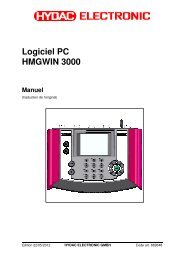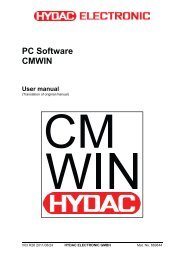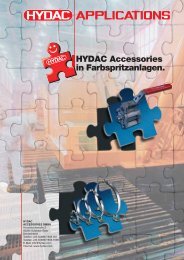CSI-F-10 User manual - Hydac
CSI-F-10 User manual - Hydac
CSI-F-10 User manual - Hydac
- No tags were found...
Create successful ePaper yourself
Turn your PDF publications into a flip-book with our unique Google optimized e-Paper software.
GSM Radio Module <strong>CSI</strong>-F-<strong>10</strong> Page 949.4.<strong>10</strong> Tabular IndexThe Tabular index function is the counterpart to the Tabular valuefunction. The input value is sorted into a parameterizable numericaltable, which must be organized in order of increasing values, andthe number of the tabular entry is output.If, for example, the first tabular entry is 4 and the second is 7.8, thena 0 will be output for all input values less than 4, the value 1 will beoutput for all values between 4 and 7.8, and the value 2 for allvalues greater than 7.8.The table is defined using the Table parameter. Each value musthave a line of its own at the time of entry. Empty lines are removedautomatically. The number of values will also be definedautomatically on the basis of the available lines. It must be between2 and 20.This function can be used for flexible range definition. Thus, forexample, limits can be defined in the table when a value is normal,suspicious, critical and very critical.Inputs: x: Value in the table (Numerical).Outputs: y: Index of the value / Value range (Numerical).Parameters: p 1 : Table (values table)9.4.11 Characteristic CurveThe Characteristic curve function is used to convert input valuesfrom one range into another. The conversion can be subdivided intovarious segments through the specification of up to 20 nodes.The Table parameter is used to specify the nodes. Each value pairis in a different line in the table. The values for x and y are separatedby a colon. The x values must be listed in ascending order. No xvalue may appear more than once. Empty lines are removedautomatically. The number of values will also be definedautomatically on the basis of the available lines. It must be between2 and 20.The ranges between the nodes are interpolated linearly; the valuesoutside the nodes are extrapolated from the last segment. Alimitation is easy to set up by simply setting another node nearbythat has the same y value. If for example the range of 0 to 450 is tobe converted to percent and at the same time limited to 0 and <strong>10</strong>0,then this is accomplished with the following value pairs:-1: 00: 0450: <strong>10</strong>0451: <strong>10</strong>0Inputs: x: X value of the characteristic curve (Numerical).Outputs: y: Function value from the characteristic curve (Numerical)Parameters: p 1 : Table (values table)Status 2011/08/17 HYDAC ELECTRONIC GMBH Part.-Nr.: 669752
















